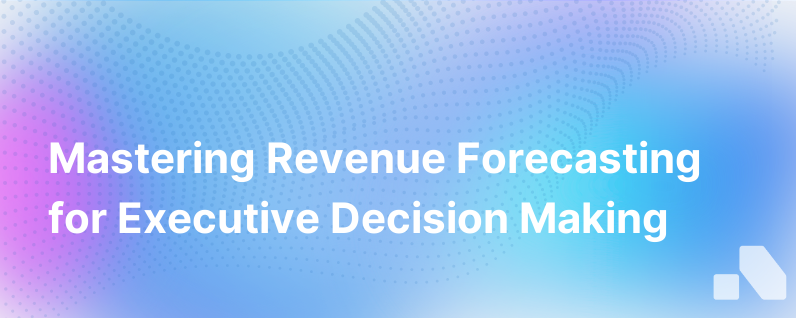Revenue Forecasting
Published on November 27, 2023 by David Zhang
Revenue forecasting is the backbone of any growth-oriented business, be it a nimble startup or a sprawling enterprise. It’s not just about predicting the future; it's about scripting it. With an accurate revenue forecast, companies can make informed decisions, plan strategically for growth, manage cash flow effectively, and provide stakeholders with a clear view of the business's financial trajectory.
In a marketplace that's constantly shifting due to technological innovations, evolving consumer preferences, and global economic uncertainties, the ability to forecast revenue with a reasonable degree of accuracy is more crucial than ever. Here we delve into why revenue forecasting is essential, the methodologies used, the challenges faced, and how businesses can enhance their forecasting accuracy.
Understanding Revenue Forecasting
Let’s start with understanding what revenue forecasting is: it’s a process where businesses estimate the amount of revenue they will generate in a future period. This forecast can cover various timescales—monthly, quarterly, or annually—and can be broken down by product lines, business units, or market segments.
The Importance of Revenue Forecasting
Revenue forecasting is not merely a fiscal exercise; it is the linchpin in a company’s strategic and operational planning. Here’s why it matters:
- Strategic Planning: A reliable forecast allows a business to set realistic goals for growth and expansion. It’s a vital input for strategic decisions, such as entering new markets, launching new products, or scaling operations.
- Financial Management: With a clear revenue estimate, companies can manage their budgets, control expenses, and make important investment decisions. Effective forecasting underpins cash flow management, a critical factor in the survival and growth of any business.
- Performance Tracking: Forecasts serve as a benchmark against which actual performance is measured. By analyzing variances between forecasted and actual figures, businesses can identify areas that require attention and adjust strategies accordingly.
- Stakeholder Communication: For public companies, or those seeking investment, accurate forecasts are essential for maintaining investor confidence. They help manage shareholder expectations and support the company's market value.
Methodologies of Revenue Forecasting
There are several methods a company can employ when forecasting revenue, each suited to different business models and levels of historical data:
- Historical Data Analysis: This method relies on past sales data to predict future revenue. It's most suitable in stable environments where past patterns are likely to continue.
- Time Series Analysis: Time series forecasting entails sophisticated statistical techniques to model and predict future values based on previously observed values. This method can account for trends, seasonal patterns, and business cycles.
- Regression Analysis: Useful when revenue is closely tied to specific economic indicators or other quantifiable factors, regression analysis can determine how changes in these variables might affect future revenue.
- Market Testing: A business may use market testing for new products or in new markets. This involves launching a new offering in a limited area or to a specific segment and gauging the response to predict wider market performance.
- Sales Force Composite: This bottom-up approach gathers forecasts from individual salespeople or units based on their knowledge of their market segments, which are then aggregated to develop a forecast.
Companies often use a combination of these methods to arrive at a comprehensive forecast.
Challenges in Revenue Forecasting
Despite the importance of revenue forecasting, there are numerous obstacles that can affect its accuracy:
- Market Volatility: Rapid changes in market conditions render historical data less predictive.
- Data Quality: Forecasts are only as good as the data they're based on. Poor data quality can lead to skewed results.
- Economic Fluctuations: Economic downturns, inflation, interest rate changes, and other macroeconomic factors can drastically affect purchasing behavior.
- Consumer Trends: Changing consumer preferences can unpredictably alter demand for a product or service.
- Product Lifecycle: As products mature, the pace of growth can slow, making forecasts based on early-stage growth rates inaccurate.
- Political and Regulatory Changes: New regulations, trade policies, or political instability can have unforeseen impacts on business operations and revenues.
Improving Revenue Forecasting Accuracy
Businesses can address forecasting challenges by:
- Leveraging Technology: Advanced analytics and AI-powered tools can process vast datasets quickly, identify patterns, and improve forecasting accuracy.
- Maintaining Robust Data: Ensuring data accuracy and consistency is paramount. Adequate investment in data management is essential.
- Continual Review and Adjustment: Forecasts should be living documents, regularly assessed and revised in light of new information.
- Integrating Market Knowledge: Incorporating insights from market research and competitive intelligence can refine forecasts.
- Scenarios and Contingencies: Developing multiple scenarios based on different assumptions can prepare businesses for various eventualities.
In conclusion, although no forecast can predict the future with absolute certainty, a detailed and well-researched forecast can provide a company with a crucial navigation tool in an ever-changing business environment. By understanding the importance of revenue forecasting, the methodologies at their disposal, and the tactics to improve accuracy, businesses can position themselves to make strategic decisions with greater confidence and resilience.
The future may be uncertain, but a robust revenue forecasting process ensures that your business isn't left in the dark. As a B2B sales AI platform, Aomni can also support enterprises in their quest to achieve more accurate revenue forecasts by offering dynamic tools that adapt to market conditions and customer behavior patterns, leading to more precise and actionable sales insights.